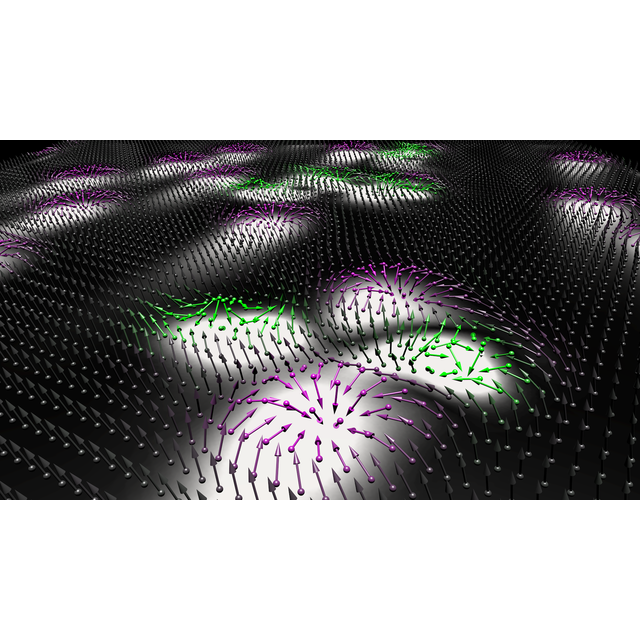News from Institut des sciences de l'ingénierie et des systèmes (INSIS) of CNRS - October 1st, 2018 (released in French)
Researchers from the Centre for Nanoscience and Nanotechnology (C2N) and their European colleagues have brought to light some surprising behaviour of nanoscale magnetic particles called skyrmions, and antiskyrmions, their antiparticle counterpart, in a ferromagnetic material. These results, published in the journal Nature Electronics, offer new avenues for information technologies.
Skyrmions are nanoscale magnetic particles that represent an excitation in magnetic materials1 and are promising candidates for future information storage and processing devices. Theoretically, skyrmions and their antiparticle counterpart, antiskyrmions, possess a property called “topological charge” which governs their dynamics. When skyrmions and antiskyrmions are subjected to a force, one charge gets deflected to the right, for example, while the opposite charge is deflected to the left. This simple picture remains to be tested, which motivated a theoretical study involving scientists from the Centre of Nanoscience and Nanotechnology (C2N, CNRS/Université Paris-Sud). They modelled the behaviour of such particles in a ferromagnetic ultrathin film under the influence of applied electrical currents.
While the simple picture is confirmed at low currents, the scientists showed that departures from the expected behaviour appear when progressively larger amounts of energy are transferred to the antiskyrmions. For the antiskyrmions, deviations from the usual rectilinear motion in the form of curved trajectories first occur as transients, then continuously2 as the current is progressively increased, while skyrmions undergo rectilinear motion for all values of the applied current. These results show that opposite topological charges can behave very differently. Another discovery involves higher energies, where antiskyrmions generate skyrmion-antiskyrmion pairs periodically. The skyrmions created propagate away readily, while their antiparticle counterparts remain closer to the point of generation and subsequently become new sources of pairs. An excess in skyrmions is often found, indicating an imbalance between topological matter and antimatter in these magnetic films. This work might therefore provide hints for solving another mystery on a cosmological scale, namely, why there exists more matter than antimatter in the universe.
1 For example, in nanoscale magnetic films that form the basis of hard disk drives and magnetic memories such as “STT-RAM”.
2 In this case the trajectories are described by trochoids, which are like curves traced out by the pedal of a bicycle that is pedalled along a straight line.
Caption: Matter and antimatter in the nanoscale magnetic universe: A gas of skyrmions (purple) and antiskyrmions (green) generated from the trochoidal dynamics of a single antiskyrmion seed. [https://doi.org/10.6084/m9.figshare.6977366.v1] © C2N
References:
Trochoidal motion and pair generation in skyrmion and antiskyrmion dynamics under spin–orbit torques
U. Ritzmann, S. von Malottki, J.-V. Kim, S. Heinze, J. Sinova, B. Dupé.
Nature Electronics, vol. 1, 451-457 (2018)
DOI: https://doi.org/10.1038/s41928-018-0114-0
Contact:
Joo-Von Kim – CNRS Researcher at C2N
Contact communication INSIS:
insis.communication@cnrs.fr









